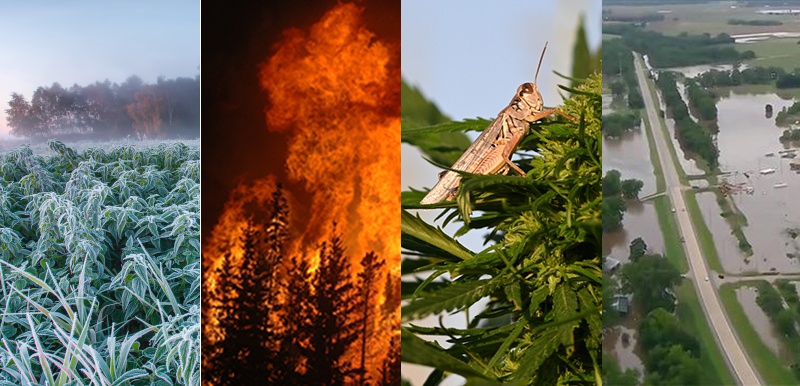Wildfires, insect infestations, cold weather, fungus and flooding have all caused major headaches for U.S. hemp farmers this year, wiping out many and demonstrating in stark relief that hemp is not immune to common problems that affect other crops.
Broad swaths of hemp fields have been destroyed in California and Oregon by the massive fires that continue to rage in the western USA, resulting in millions of dollars in losses for farmers, officials in the two states have said. Both states are leading U.S. hemp growers.
Typical farming risks
“Industrial hemp cultivators face the same climate-related risks that other agricultural operators . . . face,” Donna Durckel, a spokesperson for the Department of Agriculture in the County of San Diego, California, one of the areas hardest hit by the fires, told the San Diego Union-Tribune.
Hemp crops were destroyed not only by flames but also from smoke and falling ash. Smoke affects the quality and taste of hemp, while ash particles from burning buildings and other infrastructure threaten contamination from toxic chemicals. Experts said arsenic, heavy metals, transformer and brake fluid along with fire-fighting chemicals are all potential threats.
A group of cannabis stakeholders in Oregon have partnered to support those impacted by helping to raise funds on behalf of United Way of Jackson County for recovery from the devastating fires.
Insects, cold weather
Fields in Oregon as well as Montana were also beset by a grasshopper invasion that hit the U.S. northwest, with some growers estimating 80% of their fields were visited by the pests, damaging 25% of their crops.
Meanwhile, in Colorado an early cold snap brought freezing temperatures and a heavy snowfall, hitting outdoor grows; the state saw temperatures drop from 93° (33°C) to 31°F (-0.5°C) from Monday to Tuesday, Sept. 7-8, setting a record for the biggest 2-day temperature dip ever recorded for the month. Six inches of snowfall buried many hemp fields. Stakeholders say the result could be a curbed supply of CBD extract in the state from this year’s harvest.
Fungus and floods
In the southern USA, hemp farmers in Lousiana and Arkansas also had problems. Those who planted in the first year of legal growing in Louisiana suffered from southern blight, a soil-borne fungal disease that can kill as much as 20% of the plants it infects, with some farmers reporting 30%-50% losses. Some farms in the state, where 100 licensed producers planted hemp on about 2,500 acres (1,000+ hectares), also suffered root rot, which is a water mold, agriculture officials reported.
Finally, some crops in the state of Arkansas were hurt by rains and flooding along the Arkansas River. And 21 percent of licensed cultivators in that state reported at least partial losses from plants stolen by thieves believing they were marijuana.

